Point of Contact
Local happenings in contact improv dance
Vol. 1 - Number 3
Madison Area Contact Improv
Weekly contact improv dancing events ("jams") are held twice weekly on:
| SUNDAY 6:30-8:30 |
| |
| |
WEDNESDAY 7:15-9:15 |
| at the Hancock Center |
| |
| |
at Main Street Yoga |
| 16 N. Hancock St., Madison, WI |
| |
| |
1882 E. Main St., Madison, WI |
| $5.00 donation requested. |
| |
| |
$5-10 donation requested. |
INSTRUCTION
The first 30 - 45 minutes of the Wednesday jam will be basic contact improv instruction by a rotating group of local teachers. Newcomers are highly encouraged to attend Wednesday night.
For more information call Nataraj at (608) 246-2092 or go to Glacier Dancer.com and click on the Madison link.
Feature Article
Principles of Guided Chaos
by Nataraj Hauser
The following was written at the tail end of my martial arts practice. Initially I had intended it to be the foundation of my teaching of martial arts, but the concepts apply equally well to contact improv dance. I took the article I had started and freshened it up a bit, leaving the context in place. You the dancer can extrapolate from the combat examples and substitute dance moments in their place. It's what I do every time I dance.
During the year or so after attaining my black belt that I continued training in tae kwon do, I was looking at my ongoing study with an eye toward teaching. I considered what I had learned over the preceeding years and how I had learned it. The way others had learned and comments made during training also began to shape my development. Eventually I began a process of codifying some of the underlying principles that made one a successful martial fighter as opposed to a person who demonstrated the forms of the style with elan. Eventually my ongoing quest for experience took me away from tae kwon do and on to a period of years akin to the life of a ronin - a masterless warrior. I explored other schools and martial arts, seeking that which worked and discarding the rest. While it seems obvious to me, I feel compelled to point out that what I was learning was what worked for me. My cross training took me into aikido, Muay Thai kickboxing, capoeira, Northern Shaolin kung fu, and even a bit of fencing. As that training washed over me, I saw a few patterns beginning to emerge and I started making notes under the heading "Principles of Guided Chaos".
Why 'Guided Chaos'? As I spent more and more time in the ring sparring with one or more opponents, it became increasingly clear that one could never really control a fight. There were simply too many variables to manage. My opponent might be an inexperienced fighter, and thus do rather foolish things that an experienced fighter would not. In an effort to not follow through and hit, and possibly hurt this beginner, one might in turn be hit by a strange technique. If my opponent was a more experienced fighter, he might be able to prey upon my foibles or 'tells' and thus catch me off guard just when I thought I was doing fine. An opponent using a different style also exposed my training traps and patterns acquired from insufficient experience outside my own style. In order to deal with this constant flow of unpredictable events - chaos - one needs to develop metatechniques that allow him to alternately flow with and guide this situation of constantly changing events. Those things are (1) Looseness and flexibility, (2) Confidence Regardless of Position, (3) Expanded Awareness, and (4) Body Unity. I'll explore each of these.
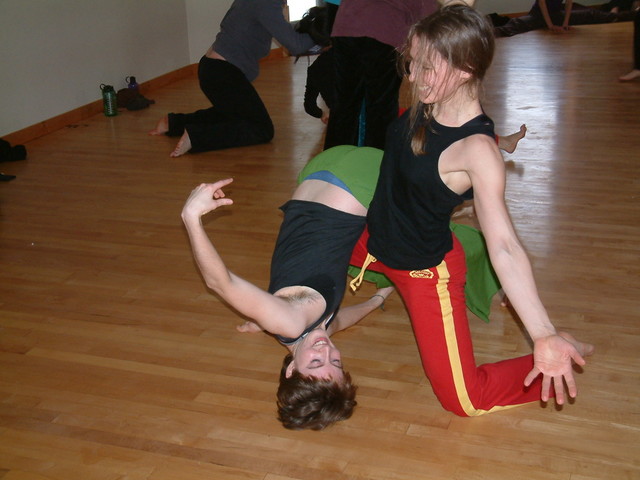
Looseness and Flexibility - While on the surface these should not need any explanation, I think there are a couple of points worth making. When your body is tense, with muscles contracted and engaged, you are inflexible and S-L-O-W. You're body cannot respond quickly to events that are rapidly unfolding. You must either try to "muscle" your way through the moment or spend precious time loosening the muscles to flow with the event. When I say flexibility I am refering to an effective range-of-motion. With a high degree of flexibility your body can flow with an event without disrupting the entire structure (perhaps causing you to fall without intent).
Confidence Regardless of Position - There are many situations that can arise that cause your body to be in a less-than-optimal position for effective techniques. A simple evasion or clash can cause a momentary loss of balance. Instead of wasting time trying to regain balance and find a point of confident position, the successful artist will learn to confidently execute an appropriate technique from that less-than-optimal position. With appropriate training one can learn to ignore the concept of 'proper stance' and be effective regardless of his orientation to the horizon. Learning to operate in an out-of-balance state with confidence will allow the practitioner to respond effectively in any circumstance.
(Photo by Nataraj Hauser)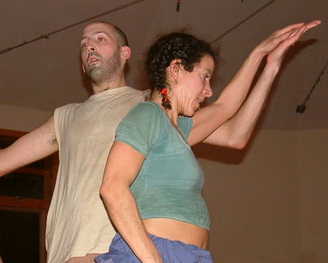
Expanded Awareness - There is a tendency when sparring to focus one's awareness on one's opponent; the clear and present danger. This is a trap to be avoided. One's opponent is only one of the elements that will influence this bout. In a dojo the floor is generally flat and without obsticles. However, in any other circumstance, and indeed in many dojos with undefined sparring areas, there can be many topographical hazards as well as other students or equipment in the way. Train instead to open your awareness to treat your opponent as just one more element to consider. Your mind/body will register the incoming technique, be it fist, foot, knee or elbow, much faster and will also let you be aware of the terrain risk so that you can avoid it, or use it to your advantage by steering your opponent so that it becomes his risk. Soften your vision rather than focusing on your opponent and you will see more and have more information to guide your responses. This will take time to perfect. If you wear corrective lenses, particularly for nearsightedness, try sparring without them - fighting blind as it were - and this may actually help you by introducing a physical limitation that needs to be compensated.
Body Unity - In a sparring situation I mentioned that it is advantageous to be loose and flexible in order to maintain speed and flow. This is true until the moment that you need to have your body respond in concert - such as the moment a technique is delivered. This means that at the precise moment when a punch is to connect, your entire body must be working in unity to deliver that punch. Some small bits of your attention may be distracted by the last moment of a block or the last technique, but at the moment of the punch, your fingers, hand, arm, shoulder, abdomen, hips, glutes, thighs, calves, feet, and toes must be involved for the portion of the second needed to deliver the punch effectively. That tiny incriment of time is the 'moment of unity', often accompanied by the kiai(*). As soon as the punch is accomplished, the body needs to again relax completely to allow flexibility and looseness. The same is true in the moment of taking a fall or throw: Your body must instantly work in concert to initiate the correct position for the fall then totally relax to take the fall without injury and flow back to a position for response (which may occur before regaining one's balance).
Using these four concepts will allow the practitioner to manage, or guide, the chaos of martial combat. There is no chance of controlling all of the elements of a bout, and thus the skilled practitioner will use these metatechniques that allow him to alternately flow with and guide this situation of constantly changing events. As your opponent unleashes his techniques upon you, your speed will be enhanced because you are loose and flexible, not needing to first get past your own muscles. Because you are skilled at operating out-of-balance your techniques can emerge faster and from unsuspected angles. Your expanded awareness provides a constant stream of data about your environment that let you avoid surprise from uneven terrain or other obsticles. And because your body can achieve unity on demand you can deliver effective techniques and instantly return to a state of looseness and flexibility.
----------
(*) Kiai The martial arts "yell". The word "kiai" itself suggests many things. The "ki" in kiai refers to energy, (chi or qi in China), believed to be an essential force behind health and vitality, but more so, something able to be nurtured, built and stored within the body for use. "Ai" means to meet, harmonize, join or fuse. Thus by this definition kiai is more than an explosive voice sound; it represents the projection of sound fused with energy or spirit that blends with the energy or spirit of the opponent, thus having an effect. When the two syllables are reversed you get another related martial arts term, "aiki", which means the meeting or harmonizing of energy (ki) central to aikido and aikijutsu. Kiai refers to spirit or vital body energy that interacts without physical contact, while "aiki" refers more to the physical energy of movement. The two are very much related.
- Christopher Caile, FightingArts.com
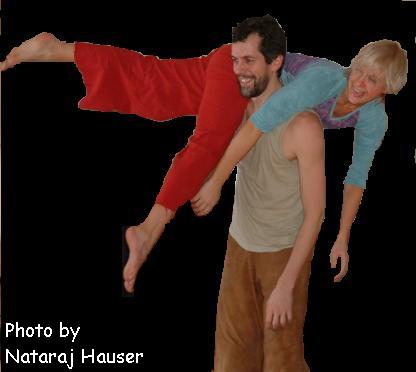 Roots Moment
Roots Moment
“Discipline within contact improvisation is to be and remain in the present with your partner – NOW! Improvisation is the art of the immediate. Finely tuned to your present state, that of your partner, your environment, the atmosphere, the dynamic of continual change and awareness of what is, not what you think it should be!”
- Thomas Kaltenbrunner
Contact Improv 101
from Liz Lehrman's DanceExchange website.
Step 1. Observe and Move: Look around the room and find three things you haven’t noticed before. Choose one of these objects and make a movement that reflects, encompasses, embodies, traces, reacts to, or enacts a function of that detail. Reflect on the strategies you used to derive movement.
Step 2. Deeper Detail: Next look carefully at the object and try to describe it in exact terms: Observing the air conditioning duct you might say: “Let’s see… I count eight screws, there’s a small lever, two sets of louvers pointed in opposite directions. On the left a couple of the louvers are dented so they curl down. One corner is bent and the paint is chipping where it’s screwed into the wall.” You may wish to draw attention to particular features that make it rich with movement potential, particularly verb phrases like “pointed in opposite directions,” “dented,” “curl down,” “chipping,” “screwed into the wall.” These action ideas are important because as dance-makers we are looking for the kind of detail that makes us have to move. Now repeat the exercise of giving movement to this physical evidence, this time based on the more detailed description.
Review. Note the difference between the first experience of making movement and that based on the more detailed description. Which was more fun to do? Which made more interesting movement? Which generated an idea that might be worth expanding upon? Usually the response will draw attention to the richness of working from the more deeply observed detail.
Interesting Links
Contact Quarterly - Perhaps the premiere US-based magazine about contact improv. Consider subscribing. (http://www.contactquarterly.com/)
Moab Jam – It’s not just a jam! (http://www.moabjam.com/)
Take a look at photos of local CI events. (http://contactimprov.tripod.com)
Ripples…
Quirky snips of where contact improv is popping up in the world of movement.
Touch me
Experimental dance sessions resemble group gropes, but sex isn't the point
BY THOMAS BELL - thomas.bell@creativeloafing.com (07.07.05)
(Photo of Sandra and Christine Yee, with Adam Gottlieb)
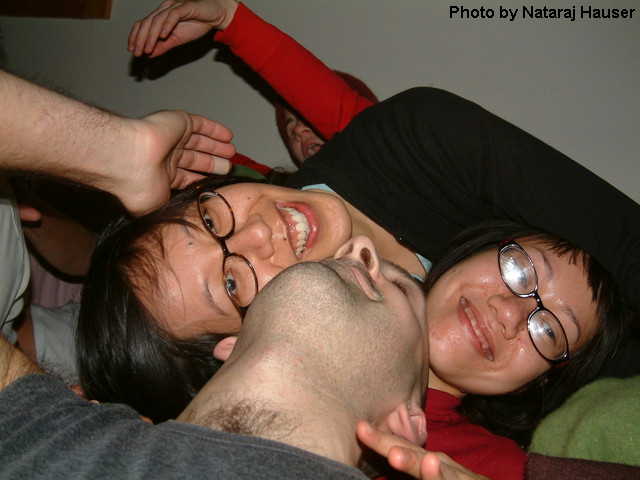 So I'm writhing around on the floor with Sandra Yee. I'm sweating pails, leaving twisted trails on the floor. We're in constant motion but always pressed together: butt to butt, belly to belly, legs intertwined, rolling, she's on top, I'm on top, lifting each other and lowering. She's letting out these high-pitched luxurious sighs, her head tilted back. And, oh yeah, several other paired-off couples are doing similar things nearby, though Yee and I are too wrapped up in each other to pay much attention.
So I'm writhing around on the floor with Sandra Yee. I'm sweating pails, leaving twisted trails on the floor. We're in constant motion but always pressed together: butt to butt, belly to belly, legs intertwined, rolling, she's on top, I'm on top, lifting each other and lowering. She's letting out these high-pitched luxurious sighs, her head tilted back. And, oh yeah, several other paired-off couples are doing similar things nearby, though Yee and I are too wrapped up in each other to pay much attention.
What? No, you dirty bird, this is not a night at the Velvet Heaven. This is a dance class. Sheesh. Not that you're the first person to get confused by contact improv, a dance technique pioneered in the 1970s by post-modern dancers and choreographers as a collaborative method to develop new movement and partnering techniques. It's mostly free-form - heed your partner's movement, and move as you both are moved - the only rule being that, most of the time you and your partner should be touching: lifting one another, crawling onto one another, pressing into one another, and doing whatever else your two joined bodies can figure out between them. Imagine folks getting highly creative with that old team-building exercise where you stand back to back and try to sit down and stand up. Contact is much more open-ended than that, but the basic dynamic is about the same.
"No boundaries," says instructor Patton White as he begins the first workshop in a new weekly session, organized by Yee, that continues through the rest of the summer. But, "Take care of your own safety. ... Listen. ... Communicate."
That "no boundaries" part has given contact improv a sketchy reputation in some circles. Dance sometimes morphs into group gropes or fuzzy-brained touch therapy. Word gets out, and with a flush like you'll see at the mention of Burning Man or cuddling parties, people who don't care a lick about dance start to get in on the action. "Workshops" become "parties" and "jams." "Dance" becomes "play." Serious dancers start to check out of the practice.
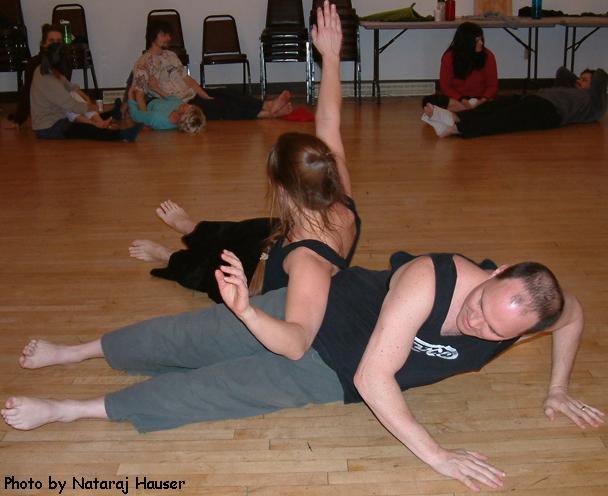 When I found out that contact improv was returning to Atlanta after an extended absence, I wondered if this workshop would suffer the same fate. Were we going to learn how to dance or were we going to have a weekly pile-on debauch? Would we discover new and surprising movement phrases or transform it all into some sweaty tantric search for revelation? Let's say that I was undivided in my hope that this workshop would remain pure in its devotion to dance.
When I found out that contact improv was returning to Atlanta after an extended absence, I wondered if this workshop would suffer the same fate. Were we going to learn how to dance or were we going to have a weekly pile-on debauch? Would we discover new and surprising movement phrases or transform it all into some sweaty tantric search for revelation? Let's say that I was undivided in my hope that this workshop would remain pure in its devotion to dance.
After holding the first session in a studio at Several Dancers Core, we move to the church (temple? Architecturally pleasing contemplated abyss?) of the First Existentialist Congregation of Atlanta. This is not a good sign, I'm thinking, as I meet Solomon Simmons, who introduces himself to me as a "transparency seer."
Later that night, after White finishes his regular 30-minute skill-building segment and turns the floor over for 90 minutes of open dance, I see Simmons alone, spinning and shuffling from side to side. As I move toward him, I overhear White talking to another dancer. "Contact," he says. "You don't have to be touching. It can be cosmic energy."
So I fit my body into the open spaces traced by Simmons' body, but a foot or two away from him, then a little closer. He starts responding to my movement, and though we're not touching, we're moving as though we are. There's an almost animal quality expressing itself through our bodies in a language that signifies a physical confrontation but actually isn't one. There's an aggressive energy between us on the edge of hostility - I don't know why - but our bodies seem to be working it out, finding a way for us to share the same space.
Eventually we do touch and move together and press against each other and hold and lift and trust. There's a union, an unspoken communion between us. "I felt like our spirits were speaking to each other," Simmons says later. That night, I have vivid dreams, including one in which I am standing next to my brother, who was killed in a car wreck nearly eight years ago, and I have my arm around him and am holding him close.
Oh, crap, I'm doing it, aren't I? Going all archetypal and alpha-wave addict. This is dance. I have to keep reminding myself of this. Dance.
Photo by Nataraj Hauser
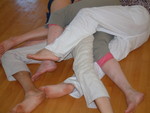
Dancing with Brooks Emanuel, I find ... we find surprising new ways to fit our legs together and move ourselves as one mass. Lauryn Menard and I figure out how to adapt our partnered movement to the substantial difference in height between us. Louise Runyon shows me the meaning of stability as I give her all my weight and lay suspended on her back.
Dance, not spirituality. Partnered movement, not sex.
Except that the more I dance contact improv, the less I can maintain these binary oppositions.
We move in the undefined spaces. It's not sex, but it is intimate, sensual ... it feels really good. Contact improv doesn't cure all that ails us, but in laughter and body play, we soothe at least some of the hurts and heartaches of the everyday. It doesn't transmute us to nirvana (still here, writing), but through improvising with a partner, we do learn to heed energies and orders outside our own motives and preconceived notions.
For now, at least, we're finding all good things in the place where dance and all the rest make contact.
A New Theatrical Medium
Excerpt from danceviewtimes.com by Paul Parish
The following is excerpted from a review of the performance "Quest" by the San Francisco troup Loose Change. The troup blends styles, Lindy, Hip-Hop, and Contact Improv, plus yoga, aikido and capoeira, and none of the dancers came from a ballet or modern dance background. The author enjoyed the performance but had a difficult time relating to the choreography as it collided with contact dancing. What follows are some of his thoughts.
Social dancers can dissolve egos into the oceanic crowd on the dance floor. But the problem of fates remains: every time you ask someone to dance; you offer the hand, but will they accept it? Sometimes after a failed dance you wish you hadn't ventured. It's like those conversations where you finish each other's sentences—in a good dance, you know how your partner feels as well as you do your own feelings. Without thinking how - you certainly can't stop to think—you know when it's happening that your partner likes the feeling, too. It is this intoxicating experience of intuiting the other person's sensations which causes leaders to learn the followers' moves, and vice versa, to heighten the connection even further next time.
(Photo by Nataraj Hauser)
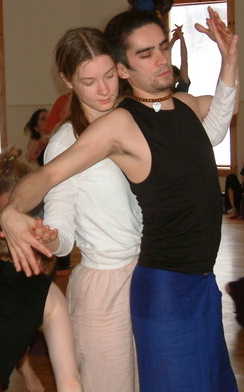
Well, the difficulties a Lindy/funk/hip-hop based company will face resemble those of Contact improv dancers in another very big way - how do you take such inwardly-directed dancing and open it up, present it to onlookers.
"Contact" dancers typically tune inward to the proprioceptors. They dance commonly with a glazed expression, using a soft, unseeing focus that uses peripheral vision only, which many observers find annoying in the extreme. But what can make a great contact dance exciting to watch is the emotional changes that affect that glaze as the dancer responds to the rapid changes of balance as the dance evolves, the vertiginous falls that must get turned into lateral rolls by the sequencing process—most of all, it is the hormonal changes, the rushes of adrenaline as the dancer adjusts to rapidly emerging circumstances (rolling up onto a partner's shoulders, sliding down the back, falling like a cat, whatever). Since it's a dance truly in all three dimensions, upside down being one of the standard states and all-fours another, the weight transfers approach the limits of what's possible without added horsepower. Since the dancers are barefoot and covered in nothing more substantial than stretch jersey, they glow with heightened muscular sensuality.
I remember watching in awe as [troup dancer] Owen Donnelly ran some pop-and-lock moves out his shoulder, down his arm, through the hand of his incomparable partner Claudine Co, which went up her arm through her spine and out into the little finger of the other hand, around midnight on a dance floor in downtown SF back in 1998. I have to say, I have clearer memories of that dance (which I watched as a wallflower) than I do of anything that happened in the staged show last night. And thereby hangs a tale: the spontaneity that gets lost when any improvised dance form gets mined, carved up, rehearsed, and presented to the public is the hardest value to get back—but without it, well, it has all the life taken out of it.
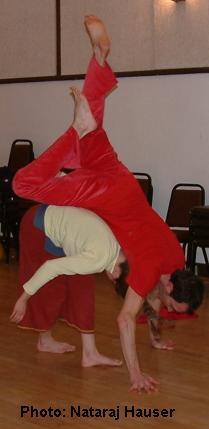 Call For Submissions
Call For Submissions
If you have something you’ve written that you want to get out to our community: An article, a poem, or even just a paragraph you think is important, send it to me and I’ll include it. (nataraj.hauser (at) gmail.com)
One request has been for more photos, so I included a bunch in this issue. If there is something else *you* would like to see, let me know.
Join Us!
Find us online at our Yahoo’s eGroup:
Groups.Yahoo.com/group/MadisonContactImprov

Click to join MadisonContactImprov
Dance Forever!


 Roots Moment
Roots Moment So I'm writhing around on the floor with Sandra Yee. I'm sweating pails, leaving twisted trails on the floor. We're in constant motion but always pressed together: butt to butt, belly to belly, legs intertwined, rolling, she's on top, I'm on top, lifting each other and lowering. She's letting out these high-pitched luxurious sighs, her head tilted back. And, oh yeah, several other paired-off couples are doing similar things nearby, though Yee and I are too wrapped up in each other to pay much attention.
So I'm writhing around on the floor with Sandra Yee. I'm sweating pails, leaving twisted trails on the floor. We're in constant motion but always pressed together: butt to butt, belly to belly, legs intertwined, rolling, she's on top, I'm on top, lifting each other and lowering. She's letting out these high-pitched luxurious sighs, her head tilted back. And, oh yeah, several other paired-off couples are doing similar things nearby, though Yee and I are too wrapped up in each other to pay much attention.
 When I found out that contact improv was returning to Atlanta after an extended absence, I wondered if this workshop would suffer the same fate. Were we going to learn how to dance or were we going to have a weekly pile-on debauch? Would we discover new and surprising movement phrases or transform it all into some sweaty tantric search for revelation? Let's say that I was undivided in my hope that this workshop would remain pure in its devotion to dance.
When I found out that contact improv was returning to Atlanta after an extended absence, I wondered if this workshop would suffer the same fate. Were we going to learn how to dance or were we going to have a weekly pile-on debauch? Would we discover new and surprising movement phrases or transform it all into some sweaty tantric search for revelation? Let's say that I was undivided in my hope that this workshop would remain pure in its devotion to dance.


 Call For Submissions
Call For Submissions